|
|
 |
|
The Forum Romanum |
|
written
by eatonj / 09.01.2004 |
|
|
| |
Function |
| |
| |
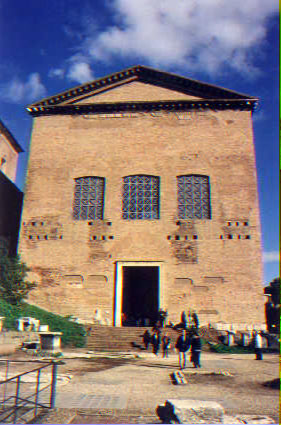
|
| http://www.umehon.maine.edu/images
/hon111/forum/Curia.jpg |
| The Curia Julia |
| Here is an actual picture of the Curia constructed by Julius Caesar. More accurately it's a reconstruction of Caesar's design for the Curia. You might notice that the Curia remains incredibly intact, while the rest of the Forum has fallen into incredible disrepair. This is because it was converted into the Church of St. Hadrian in 630 by Pope Honorius I and actively used as such until excavations. |
| |
|
| |

|
| Grant, Michael. The Roman Forum. |
| The Decorated Rostra |
| This is a representation of the Rostra with its five decorative colums in place. |
| |
|
| |
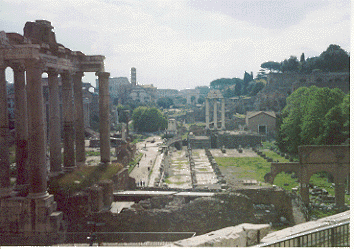
|
| http://cornellia.fws1.com/BasilicaJulia.gif |
| Remains of the Basilica Julia |
| Here is what remains of the of the great Basilica Julia where civil suits of the Roman Empire were once heard. |
| |
|
| |
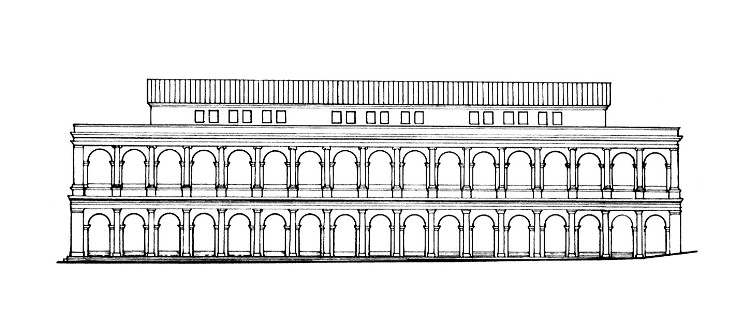
|
| Claridge, Amanda. Rome. pg 62, |
| The Basilica Julia |
| An artistic represenation of the Basilica Julia to give some idea of at least what the front of great building once looked like. |
| |
|
| |
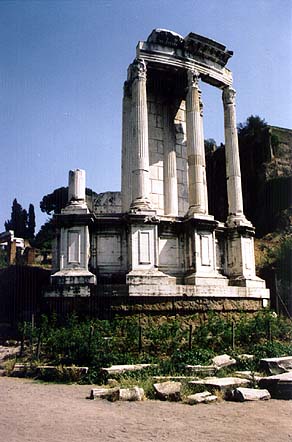
|
| http://www.vroma.org/~forum/images
/t.o.vesta.good.jpg |
| Temple of Vesta Remains |
| These are the remaing three columns of the circular Temple of Vesta |
| |
|
| |
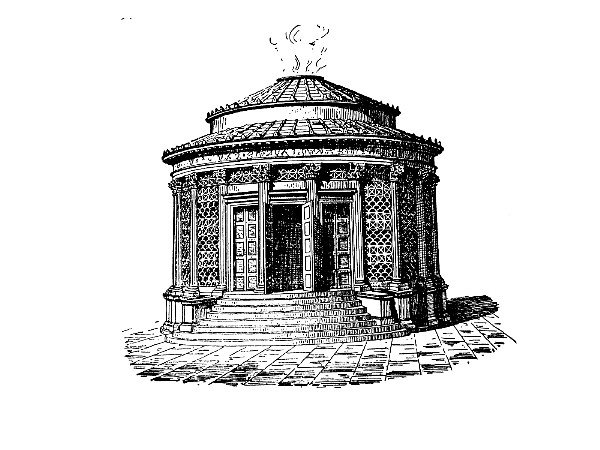
|
| Grant, Michael. The Roman Forum |
| Temple of Vesta |
| A black and white version of what the Temple of Vesta once looked like, complete with a plume of smoke out the top. |
| |
|
In function the Forum developed greatly from its humble beginnings as a water source and grazing ground to local market, to political, commercial, social and religious center during the height of Rome at the end of the republic and first few hundred years of empire. As the political center, the Forum provided the meeting place of the great Roman Senate in the Curia, where the 300 most prolific heads of families met regularly to discuss issues of the state and advised the consuls. Possibly more importantly in the Comitium assembled the active citizenry of the city. Every day during late morning hundreds would gather here to hear the news of the day being spoken from the ornate Rostra. From here they also had the opportunity to hear the greatest orators of their time such as Cicero and Claudian arguing against and for the state, sometimes speaking against the word of the emperors at great risk.
The legal center of Rome was housed in the Basilica Julia, where the Centumviri met, a board of 180 men who heard civil suits. They would hear up to four cases at one time inside the basilica, separated only by curtains, and with hundreds of people crowded into the balconies to hear the proceedings, one can imagine the amount of noise and confusion a day at the courthouse could entail. Lawyers were limited in their speaking time by water clocks, however the number of clocks awarded to speak varied depending on the importance of the speaker, in the opinion of the court. Once it was recorded that Pliny the Younger was awarded 16 clocks of water, totaling a speaking time of over five hours! More than a courthouse, the Basilica Julia, and the Basilica Aemilia on the other side of the Forum served as meeting places for people and as a covered marketplace. The Basilica Aemilia actually having built in stalls and the Basilica Julia just having merchants set up their goods along the peristyle. During the Monarchy and a part of the Republic goods sold to the north and south of the Forum (where the Basilicas would not stand for another few hundred years) were mostly food and necessary goods. However, after a decree by Consul Maenius in 338 BC banished all of the butchers and fruit stands from the Forum area, citing the smell, the old shops were replaced with more desirable shops such as bankers, money-lenders, and silver-smiths. Other popular items sold in the Forum were jewelry and gold, clothing, perfumes, bathing oils, and ointments, as well as services such as hair dressers.
As religious grounds, the Forum held temples and to many important gods, the most sacred and most ancient being the Temple of Vesta. Here the Vestal Virgins kept the sacred flame of Vesta, associated as the protectress of the Roman state during the Republic, burning at all times. Should the flame be extinguished it was taken very seriously as a prophecy for the fall of the nation. In the very center of the temple was the Penetralia, arguably the most sacred site in the entire Roman Empire. Inside were two clay jars, one empty and one containing the “holy objects” of the Roman state. So secret were the objects that only the Vestal Virgins and Pontifex Maximus knew what was inside, but it is believed that one of the items was the “palladium,” a small figure brought from Troy by Aeneas after the Trojan War. According to ancient legend the city which held the palladium could not be conquered. The second oldest temple in the Forum, and third oldest in Rome, behind the Temple of Jupiter on the Capitoline, was the Temple of Saturn, worshipped as the god of agriculture. Another of ancient religious sites was the Shrine to Venus Cloacina, built to recognize the Cloaca Maxima.
It is easy to see the logic in what early Romans felt the need to worship: safety in the Temple of Vesta, and sustainability, in the Temple of Saturn and Shrine of Venus Cloacina. Later religious monuments, constructed when the empire was expanding and no longer concerned merely with survival, recognize this change in building monuments to more warlike gods and to peace and harmony (Precinct of Harmonious Gods, Temple of Concordia Augusta). Finally, during the empire, when Rome was confident of its power and felt it had little to fear, it began to deify its own emperors who had constructed this bastion of power with monuments such as the Temple of the Divine Julius Caesar and the Temple of Antoninus and Faustina.
As a whole during the height of the Empire, while maintaining all of the above stated day to day functions, the Forum became the symbol of imperial power. New monuments were constructed to celebrate military victories and statues were erected to honor and accolade emperors. Such decoration actually began during the Republic with the ornamentation of the Rostra with the prows of defeated enemy ships and some of the most elaborate monuments we see today were constructed solely for this purpose of commemorating Rome’s strength and power, such as the Arch of Titus. The importation of new building materials, such as colorful and exotic shades of marble from Africa and the East, signified to Roman citizens just how far the expansive arms of the Empire now reached.
|
| |
|
| |
|
|
 |
|



